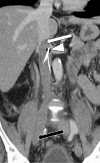Optimizing the management strategy for inferior vena cava filter
- PMID: 41081127
- PMCID: PMC12514712
- DOI: 10.21037/qims-2025-837
Optimizing the management strategy for inferior vena cava filter
Abstract
Background: Complications related to the inferior vena cava filter (IVCF) increase with prolonged dwell time. We therefore evaluated the efficacy of two new methods of monitoring patients in terms of retrieval rates, and compared them with our previous practice, which did not involve a multidisciplinary (MD) approach.
Methods: From April 1st, 2012 to October 31st, 2019, patients were monitored by the vascular medicine department, without MD follow-up. From November 1st, 2019 to October 31st, 2021, a letter was sent to the patients' general practitioner (GP) to inform them of the need for a specialist consultation to assess whether the filter was still indicated. From November 1st, 2021 to November 1st, 2023, an MD discussion was organised between the radiologist and the vascular physician to assess the indication for retrieval. This discussion systematically reviewed the evolution of the contraindication to anticoagulant therapy (AT), the initial indication for filter implantation, and the patient's life expectancy. If retrieval was considered appropriate, the patient was contacted and scheduled for the removal procedure. The retrieval rates of the different methods and the occurrence of complications were measured in each group and compared.
Results: The overall retrieval rate of IVCFs increased, though not significantly (P=0.15), from 40.5% with no specific follow-up (NSF), to 42.4% when a letter was sent to the GP, and to 49.7% when an MD meeting was implemented. In contrast, the adjusted retrieval rate improved significantly (P<0.001), rising from 62.9% with NSF, to 69.7% with a GP's letter, and reaching 97.5% following an MD meeting.
Conclusions: MD involvement in patient follow-up leads to a significant improvement in the removal of IVCF that are no longer clinically necessary. Sending a letter to the GP is effective, but MD follow-up is more effective.
Keywords: Inferior vena cava filter retrieval (IVCF retrieval); deep vein thrombosis (DVT); optimizing patients’ management; pulmonary embolism (PE).
Copyright © 2025 AME Publishing Company. All rights reserved.
Conflict of interest statement
Conflicts of Interest: All authors have completed the ICMJE uniform disclosure form (available at https://qims.amegroups.com/article/view/10.21037/qims-2025-837/coif). The authors have no conflicts of interest to declare.
Figures



References
-
- Torbicki A, Perrier A, Konstantinides S, Agnelli G, Galiè N, Pruszczyk P, Bengel F, Brady AJ, Ferreira D, Janssens U, Klepetko W, Mayer E, Remy-Jardin M, Bassand JP, ESC Committee for Practice Guidelines (CPG) . Guidelines on the diagnosis and management of acute pulmonary embolism: the Task Force for the Diagnosis and Management of Acute Pulmonary Embolism of the European Society of Cardiology (ESC). Eur Heart J 2008;29:2276-315. 10.1093/eurheartj/ehn310 - DOI - PubMed
-
- Stevens SM, Woller SC, Kreuziger LB, Bounameaux H, Doerschug K, Geersing GJ, Huisman MV, Kearon C, King CS, Knighton AJ, Lake E, Murin S, Vintch JRE, Wells PS, Moores LK. Antithrombotic Therapy for VTE Disease: Second Update of the CHEST Guideline and Expert Panel Report. Chest 2021;160:e545-608. 10.1016/j.chest.2021.07.055 - DOI - PubMed
-
- Minocha J, Smith AM, Kapoor BS, Fidelman N, Cain TR, Caplin DM, Eldrup-Jorgensen J, Farsad K, Gupta A, Lee MH, McBride JJ, Moores LK, Rochon PJ, Lorenz JM. ACR Appropriateness Criteria(®) Radiologic Management of Venous Thromboembolism-Inferior Vena Cava Filters. J Am Coll Radiol 2019;16:S214-26. 10.1016/j.jacr.2019.02.010 - DOI - PubMed
LinkOut - more resources
Full Text Sources
Miscellaneous
